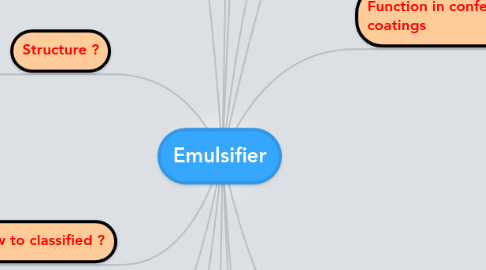
1. What is it ?
1.1. A substances which reduce the surface tension at the interface of two normally immiscible phases , allowing them to mix and form an emulsion
2. How it works?
2.1. Reduce tension between two immiscible phases due to their molecular structure
2.1.1. Emulsifier orient themselves at the phase interface and lower the interfacial enerrgy
2.1.2. Monomolecular interfacial film
2.1.2.1. Prevent the coalescence
2.1.3. Formation of steric
2.1.4. Formation of electrical barrier
3. Where it is used?
3.1. In a emulsion
3.1.1. Emulsion
3.1.1.1. Consist of two phase that are immiscible under normal condition
3.1.1.1.1. Dispersed phase
3.1.1.1.2. Continuous phase
3.1.1.2. Consist of two type
3.1.1.2.1. water in oil (w/o)
3.1.1.2.2. oil in water (o/w)
3.1.1.3. On phase is dispersed in the other in the form of fine droplets
3.1.1.3.1. The dispersed droplets
3.1.1.3.2. medium which the droplets are dispersed
4. Structure ?
4.1. Hydophilic
4.1.1. Affinity for water
4.1.1.1. Consists of
4.1.1.1.1. Anionic
4.1.1.1.2. cationic
4.1.1.1.3. Amphoteric
4.1.1.1.4. Nonionic functional group
4.2. Lipophilic
4.2.1. Affinity for oil
4.2.1.1. Consists of
4.2.1.1.1. C16 (palmatic)
4.2.1.1.2. Longer fatty acid
5. Types
5.1. Cationic
5.1.1. Posses positive charge
5.1.1.1. amine compound
5.1.2. Not used as food additive
5.1.3. Toxic
5.2. Amphoteric
5.2.1. Posses both positive and negative charges
5.2.1.1. variuos lecithin
5.2.2. Act as anionic or cationic emulsifier depending on pH of system
5.3. Nonionic
5.3.1. Uncharged molecules
5.3.1.1. monoglycerides
5.3.1.2. polyoxyethene glycol oleates
5.3.1.3. polysorbates
5.3.1.4. sucrose ester
5.3.1.5. diglycerides
5.3.2. Influenced by
5.3.2.1. pH
5.3.2.2. Salt content
5.4. Anionic
5.4.1. Posses a negative electrical charges
5.4.1.1. stearoyl lactylates
5.4.1.2. Diethyl tartaric esters of monoglycerides
5.4.1.3. succinylated monoglycerides
5.4.2. Influenced by
5.4.2.1. pH
5.4.2.2. Ionic strenght
6. How to classified ?
6.1. Throug HLB
6.1.1. What is HLB ?
6.1.1.1. Expresses the balance size and strength of the hydrophilic and lipophilic group in the emulsifier
6.1.1.2. 3-6 HLB
6.1.1.2.1. Good O/W emulsifier
6.1.1.3. 7-9 HLB
6.1.1.3.1. Good wetting agent
6.1.1.3.2. Can be used for o/w or w/o
6.1.1.4. 10-18 HLB
6.1.1.4.1. Good o/w emulsifier
7. How to select?
7.1. Evaluate different combination of two or more emulsifier to determine which gives the most stable emulsion
7.1.1. Example , do not blend anionic and cationic emulsifier as these may neutralize each other
7.2. Use only approved emulsifier
7.3. Select an emulsifier after considering
7.3.1. the functional requirement of the food system
7.3.2. The method of processing
7.3.3. The form of finished product
7.4. Consult the supplier for
7.4.1. Approximate usage levels
7.4.2. methods of incorporating the emulsifier into the food
7.5. Determine HLB requirement for the foodsystem
7.5.1. Involves screening emulsifier over a range of the HLB values and several concentrations
7.5.1.1. To determine approximate requirement then verify through experimentation
8. Function ?
8.1. To promote emulsion stability
8.2. Stabilize aerated system
8.3. Control agglomeration of fat globules
8.4. To modify texture, shelf life and rheological properties
8.4.1. By complexing with strach and protein components
8.5. To improve the texture of fat-based foods
8.5.1. By controlling the polymorphism of fats
9. Application ?
9.1. Emulsification
9.2. Antistaling
9.3. Texture modification
9.4. Aeration/ foaming
9.5. Emulsion stabilization
9.6. Solid fluidization
9.7. Crystal modification
9.8. Palatability improvement
9.9. Defoaming
9.10. Wetting
9.11. Solubilizing
10. Function in bread
10.1. Divide into two main group
10.1.1. Dough conditioner/ dough strengtheners
10.1.1.1. Aid development of less tacky , extensible dough hat are processed through machinery without tearing or sticking
10.1.1.2. Exerts their effect during fermentation ,mechanical handling , shaping and transports as well as proofing and the first part of baking time .
10.1.2. Crumb softener
10.1.2.1. Aionic emulsifier
10.1.2.1.1. Complex with starch which referred to as crumb softeners
10.1.2.2. Interact with flour components in creating longer lasting softness in the crumb of finished goods
10.1.2.3. Emulsifier-starch complex
10.1.2.3.1. Retard crystallization or retrogradation which is responsible for staling
10.1.2.4. Most effective softerners
10.1.2.4.1. Lactylates
10.1.2.4.2. SMG
10.1.2.4.3. Plastic mono and diglycerides
10.1.2.4.4. Hydrated distilledmono glycerides
10.1.2.4.5. DATEM
10.1.2.5. Typically used about 0.5-1.0% of flour weight
11. Function in ice cream
11.1. Stabilize the foam by destabilizing the product's emulsion
11.2. Displace the protein from the fat globules surface to the aqueous phase
11.2.1. Increase the liquid cream's viscosity and allows the fat globules to agglomerate
11.2.2. The increase viscosity promotes aeration while the agglomeration stabilize the air cells once air is incorporated
12. Function in Noodle and pasta
12.1. Make rigid complex with starch to protect starch granules and improve quality of starchy foods
12.2. Fresh noodles
12.2.1. Make easy to handle dough
12.2.2. Increases the water absorption rate by 1 to 2 %
12.2.2.1. Surface of noodle becomes smooth, uniform and less sticky
12.2.2.1.1. Improved for production
12.3. Instant noodles
12.3.1. Improve adsorption
12.3.2. decrease cooking time
12.4. Macaroni and spaghetti
12.4.1. Provides feeling elassticity
12.4.2. Smooth uniform surface
12.4.2.1. which inhibit sticking after boiling
13. Function in cakes
13.1. Emulsifier added to fat-containing batter function
13.1.1. Stabilize the aerated structure
13.1.2. Promote a finer distribution of fat droplets
13.2. Alpha tending emulsifier
13.2.1. Example
13.2.1.1. Acetic acid esters of monoglycerides
13.2.1.2. Lactic acid esters of monoglycerides
13.2.1.3. Propylene glycol esters
13.2.2. Contributes to a higher volume and more uniform cell structure in the finished product
13.2.3. Promote finer distribution of fat droplets
13.2.4. Increased viscosity of water phase
14. Function in confectionery product and coatings
14.1. Inhibit bloom
14.1.1. Bloom ?
14.1.1.1. Occurs when fat crystal undergo transition to form most stable crystalline form
14.1.1.1.1. Causing the cocoa butter to separate fromthe brown nonfat phase
14.1.1.2. Can be retarded with use of emulsifier functioning as the crystalmodifiers
14.1.1.2.1. They stabilize the intermediate form of the fat
14.1.1.2.2. Example of emulsifier
